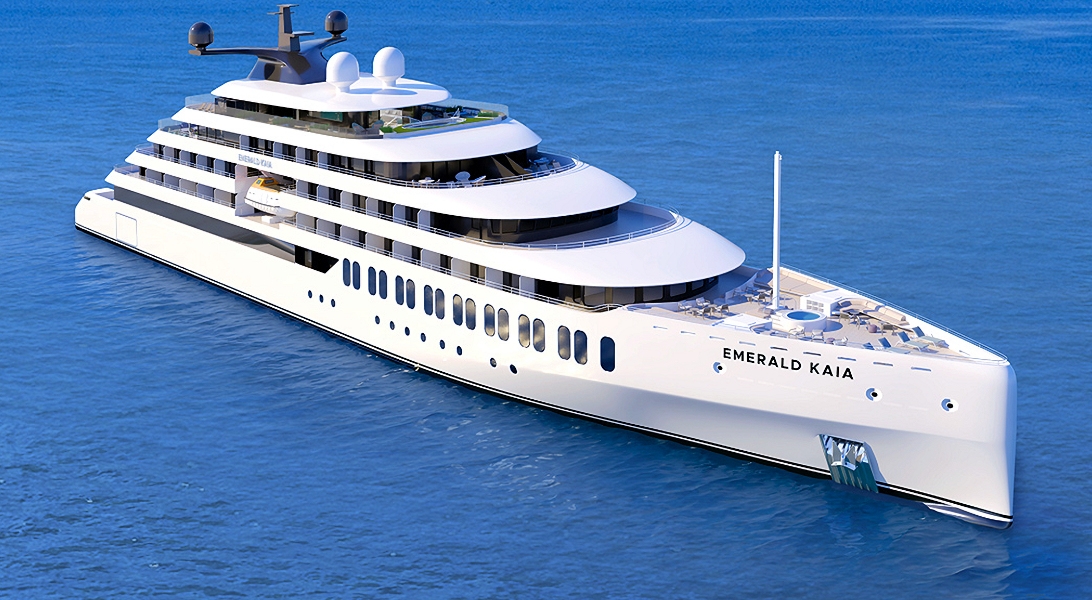This site uses cookies as defined in our Cookie Policy, by continuing to use this site you agree to their use.
Continue
| Arrive | Depart | ||||||
| 26th26 | JunJun | 202727 | Venice, Italy, embark on the Emerald Kaia | ||||
Venice is a city unlike any other. No matter how often you've seen it in photos and films, the real thing is more dreamlike than you could imagine. With canals where streets should be, water shimmers everywhere. The fabulous palaces and churches reflect centuries of history in what was a wealthy trading center between Europe and the Orient. Getting lost in the narrow alleyways is a quintessential part of exploring Venice, but at some point you'll almost surely end up in Piazza San Marco, where tourists and locals congregate for a coffee or an aperitif. Your Croatian cruise begins in the romantic city of Venice, which was founded in the 5th century and stretches across 118 small islands of the marshy Venetian Lagoon. The grandeur of this city needs no introduction, from its legendary canals to magnificent St Mark’s Basilica. Please book your flight to arrive into Venice prior to 04:00 PM. | |||||||
| 27th27 | JunJun | 202727 | Rovinj, Croatia | ||||
One of the true jewels of the Mediterranean, Rovinj is a jaw-droppingly beautiful town, which juts out into sparkling Mediterranean. Dominated by the pencil-like bell tower of the Venetian Saint Euphemia Cathedral, pine tree forests flow to the borders of the quaint Old Town - which evokes the romantic, tangled backstreets of the Venice. Rovinj - or Rovino in Italian - is a city of split personalities, with two official languages - having been owned by the Kingdom of Italy between 1919 and 1947. Located on Croatia’s Istrian Peninsula, the lovely town of Rovinj is interwoven with Italian influences. A rabbit warren of narrow, winding cobbled streets and small squares, Rovinj is a delight to explore by foot among the colourful buildings and art galleries, of which there are plenty here. On a hilltop, the belltower of the baroque-style St Euphemia’s Church pierces the sky, while down below, the picturesque harbour is filled with fishing boats, a nod to the town’s seafaring and fishing traditions. | |||||||
| 28th28 | JunJun | 202727 | Sibenik, Croatia | ||||
Šibenik's main monument, its Gothic-Renaissance cathedral, built of pale-gray Dalmatian stone and designated a UNESCO World Heritage Site, stands on a raised piazza close to the seafront promenade. From here a network of narrow, cobbled streets leads through the medieval quarter of tightly packed, terra-cotta–roof houses, and up to the ruins of a 16th-century hilltop fortress. The city has never been a real tourist destination. Before the Croatian war for independence, it was a relatively prosperous industrial center, but when the factories closed, Šibenik sank into an economic depression. However, the cathedral more than warrants a look, and it makes a decent base for visiting the waterfalls of Krka National Park. Founded by the Slavs in 1066, Šibenik is one of Croatia’s oldest towns. It’s nestled on the coast between Zadar and Split, it has been conquered by Venetians, Byzantines, Hungarians and Habsburgs, meaning there is a plethora of architectural styles to admire. This tiny city is home to two UNESCO World Heritage-listed sites: the white stone Saint James’ Cathedral, an architectural fusion of Gothic and Renaissance – take the stairs from the Riva, the seaside promenade – and Nikola Fort, built between the 16th and 17th centuries. | |||||||
| 29th29 | JunJun | 202727 | Trogir, Croatia | ||||
Located on a small island between the Croatian mainland and Ciovo Island, UNESCO-listed Trogir is an ancient settlement that dates to the Hellenistic period. It’s filled with Romanesque churches and Renaissance and Baroque buildings, with St Lawrence Cathedral dominating the old town square. Climb to the top of the belltower for spectacular views over the town. Spend time people-watching on the wide seaside promenade, which is packed with bars and cafes. | |||||||
| 30th30 | JunJun | 202727 | Vis Island, Croatia | ||||
The island of Vis served as a Yugoslav military base from the 1950s until 1989, during which it was cut off to visitors and left vastly unpopulated. This, however, has preserved the island’s authenticity and life here is very laidback and unhurried, with a rocky coastline and azure waters, and the town of Kut, which was built by the Venetians, a series of narrow passageways and ancient palazzos. The island was used as the setting for the sequel to the film Mamma Mia!, depicting the fictional Greek island of Kalokairi. | |||||||
| 1st01 | JulJul | 202727 | Hvar Island, Croatia | ||||
The Croatian island of Hvar bills itself as the "sunniest island in the Adriatic." Not only does it have the figures to back up this claim—an annual average of 2,724 hours of sunshine—but it also makes visitors a sporting proposition, offering them a money-back guarantee if there are seven consecutive days of snow (snow has been known to fall here; the last time being February 2012). Hvar is a photogenic jumble of whitewashed buildings topped with sun-kissed terracotta roofs, and beyond, scenic rolling hills peppered with lavender fields, olive groves, and grapevines. The heart of Hvar is its Old Town, which reveals multiple layers of history and architectural wonders, including the vast St Stephen’s Square, which is home to a cathedral built in the 16th and 17th centuries, and the restored Arsenal, which was used to repair and refit war galleons from the 17th century. | |||||||
| 2nd02 | JulJul | 202727 | Korčula, Croatia | ||||
Off the coast of Croatia in the southern Adriatic Sea lie some thousand islands and the largest of them, Korçula, is considered the most beautiful. With an average of 3,000 hours of sunshine per annum, which guarantees a wide assortment of Mediterranean vegetation, it is not difficult to understand why seasoned travelers compare Korçula to a latter-day Eden. Separated from the mainland by a channel of only one mile, Korçula's main town, named the same as the island, ranks among the best preserved medieval towns in the Mediterranean. It is the island's main tourist, economic and cultural center. Thanks to its strategic location along the sea trade routes, Korçula has always attracted travelers and settlers. Korcula was founded by Greek colonists, who were followed by Illyrians, Romans and finally the Croats. The Korçula Statute of 1214 is one of the oldest legal documents to have been adopted in this part of Europe. The same century saw the birth of the famous world traveler, Marco Polo. The house said to be his birthplace can be seen in town. Korçulans have always been known as keen seafarers, excellent shipbuilders, stonemasons and artists. From their many voyages, sailors brought back new ideas, which eventually mixed with local customs. To this day, Korçula has maintained the tradition of performing knightly games such as the chivalrous Moreska dance, which has been in existence for more than 400 years. Visitors to Korçula enjoy its stunning location, natural beauty and medieval ambiance. And if that's not enough, the town offers numerous attractions that are within walking distance from the pier, including the City Museum and the Bishop's Treasury. A gem of the Adriatic, Korcula is among the most beloved islands in Croatia. It boasts a landscape of olive groves and vineyards, and a striking coast of white pebble beaches and azure waters. While there’s evidence the island has been inhabited since prehistoric times, the fortified old town is on UNESCO’s tentative list for its late medieval planning and has been referred to by the locals as ‘Little Dubrovnik’. It is a delightful mix of medieval churches, elegant palaces and squares. See the impressive St. Mark’s Cathedral built in Gothic-Renaissance style, and the captivating Marco Polo Center, where you can understand the legacy of the explorer who was thought to have been born here. The villages of Cara and Smokvica are renowned for producing the country’s signature dry white wine. | |||||||
| 3rd03 | JulJul | 202727 | Dubrovnik, Croatia, disembark the Emerald Kaia | ||||
Nothing can prepare you for your first sight of Dubrovnik. Lying 216 km (135 miles) southeast of Split and commanding a jaw-dropping coastal location, it is one of the world's most beautiful fortified cities. Its massive stone ramparts and fortress towers curve around a tiny harbor, enclosing graduated ridges of sun-bleached orange-tiled roofs, copper domes, and elegant bell towers. Your imagination will run wild picturing what it looked like seven centuries ago when the walls were built, without any suburbs or highways around it, just this magnificent stone city rising out of the sea.In the 7th century AD, residents of the Roman city Epidaurum (now Cavtat) fled the Avars and Slavs of the north and founded a new settlement on a small rocky island, which they named Laus, and later Ragusa. On the mainland hillside opposite the island, the Slav settlement called Dubrovnik grew up. In the 12th century the narrow channel separating the two settlements was filled in (now the main street through the Old Town, called Stradun), and Ragusa and Dubrovnik became one. The city was surrounded by defensive walls during the 13th century, and these were reinforced with towers and bastions in the late 15th century.From 1358 to 1808 the city thrived as a powerful and remarkably sophisticated independent republic, reaching its golden age during the 16th century. In 1667 many of its splendid Gothic and Renaissance buildings were destroyed by an earthquake. The defensive walls survived the disaster, and the city was rebuilt in baroque style.Dubrovnik lost its independence to Napoléon in 1808, and in 1815 passed to Austria-Hungary. During the 20th century, as part of Yugoslavia, the city became a popular tourist destination, and in 1979 it was listed as a UNESCO World Heritage Site. During the war for independence, it came under heavy siege. Thanks to careful restoration, few traces of damage remain; however, there are maps inside the Pile and Ploče Gates illustrating the points around the city where damage was done. It’s only when you experience Dubrovnik yourself that you can understand what a treasure the world nearly lost Your Emerald Cruises voyage concludes in the grand, historic city of Dubrovnik, the UNESCO World Heritage Site known as the Pearl of the Adriatic. The city is renowned for its breathtaking architecture of red terracotta tiled roofs and whiteish walls, striking against the turquoise waters that laps below. It’s home to one of the finest examples of a medieval citadel in Europe. From your luxury yacht, you’ll be transferred to the airport for your journey home or to continue your holiday. Please book your flight to depart out of Dubrovnik after 12:00 PM. The itinerary is a guide only and may be amended for operational reasons. As such Emerald Cruises cannot guarantee the cruise will operated unaltered from the itinerary states above. Please refer to our terms and conditions for further information. | |||||||

The images shown are for illustration purposes only and may not be an exact representation of what you find on the ship.
The images shown are for illustration purposes only and may not be an exact representation of what you find on the ship.
The images shown are for illustration purposes only and may not be an exact representation of what you find on the ship.
The images shown are for illustration purposes only and may not be an exact representation of what you find on the ship.
The images shown are for illustration purposes only and may not be an exact representation of what you find on the ship.
| Return flights including luggage allowance | |||
| Overseas Transfers | |||
| 7 nights aboard the Emerald Kaia | |||
| Return airport transfers | |||
| Wine, beer & soft drinks with lunch & dinner | |||
| Gratuities Included | |||
| One complimentary shore excursion in every port | |||
| Bikes for passenger use | |||
| Free Wi-Fi included | |||
| Port Taxes and Fees | |||
 | ABTA and ATOL Protection* | ||
Fly/cruise package |
Date 26th Jun 2027 |
Nts 7 |
Interior  |
Oceanview £6,661pp |
Balcony  |
Suite £8,494pp |
Interior  |
Oceanview £13,322pp |
Balcony  |
Suite £15,155pp |
Date 26th Jun 2027 |
Nts 7 |
Interior  |
Oceanview £6,661pp |
Balcony  |
Suite £8,494pp |
Interior  |
Oceanview £13,322pp |
Balcony  |
Suite £15,155pp |




Fusion Cruises when selling travel arrangements is a trading name of The Midcounties Co-operative Ltd. Fusion Cruises is an Accredited Body Member of Midcounties Co-operative Travel Consortium. (ABTA:P6652, ATOL:6053).
Book with Confidence. We are a Member of ABTA which means you have the benefit of ABTA’s assistance and Code of Conduct.
Some of the flights and flight-inclusive holidays on this website are financially protected by the ATOL scheme but ATOL protection does not apply to all holiday and travel services offered on this website. This website will provide you with information on the protection that applies in the case of each holiday and travel service offered before you make your booking. If you do not receive an ATOL Certificate then the booking will not be ATOL protected. If you do receive an ATOL Certificate but all parts of your trip are not listed on it, those parts will not be ATOL protected. Please see our booking conditions for information, or for more information about financial protection and the ATOL Certificate go to: www.caa.co.uk
